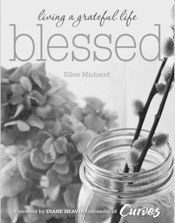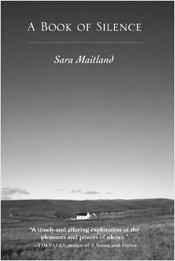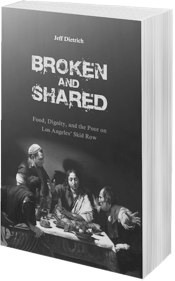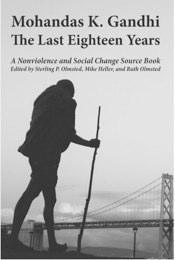Books
Staff
September 1, 2012
 Blessed: Living a Grateful Life
Blessed: Living a Grateful Life
By Ellen Michaud, Reader’s Digest, 2011. 176 pages. $16.95/hardcover, $9.99/Kindle.
In the midst of an especially rough patch in my life, I received an invitation from Friends Journal to review Blessed: Living a Grateful Life. The request was a blessing in itself!
Ellen Michaud’s little volume is a collection of online columns originally written for women. Though it emphasizes the lives and experiences of women, its stories have broad human appeal. Blessed was named the top Spiritual Inspiration Book of the Year (2011) by USA Book News.
Blessed is a good book to keep on the bedside stand, in your backpack or glove compartment. Each essay is a quick breath of inspiration and joy. Michaud is literally counting her blessings, and she finds them in everything from polishing her 260-year-old teapot, to celebrating the Kakamega Center for children orphaned by AIDS in Kenya. Her search is infectious: as I read the book, I found myself paying closer attention to gifts in my life and imagining how I could share my stories.
The essays are organized into subjects that particularly make sense to women, like “A Celebration of Friends & Family,” “Making A Difference,” and “Reinventing Who You Are.” The first section, “A Quiet Space,” focuses on relaxing our hurried pace long enough to take in the simple pleasures surrounding us. Placing this subject first reflects Michaud’s recognition of the harried lives most women lead, as we attempt to do it all. She reminds us of the power in moments of peace.
More than once as I read the book, I heard a grumbly little inner-voice say, “Of course she can rave about her blessings, she has so many!” This raises an interesting chicken-and-egg question: is it an abundance of blessings that leads us to feel grateful, or is it an “attitude of gratitude” that leads us to see blessings? Ellen Michaud writes in private correspondence that “truly seeing these blessings will lead to a deep sense of gratitude.” I believe we can enter into this beautiful cycle anywhere, whether by observing and naming the blessings that exist, or by cultivating an attitude which then converts all manner of experiences into blessings. Michaud doesn’t discuss this point, but I think she would agree that however one creates that cycle, declaring our blessings opens us to receive more of them.
Ellen Michaud is a member of South Starksboro Meeting in Vermont, and there are a number of Quaker influences in the book. Quakers appear in several stories; some sections even open with quotations by Friends. Many of the essays, rather than ending in neat conclusions, close with a query or observation that the outcome remains to be seen. Quaker values such as silence, service and transformation permeate.
I was jarred a few times by what felt like un-Quakerly sentiments. An offhand reference to a minor character as a “lowlife” implied that some of us are higher life forms. A story about Thanksgiving had no critique regarding the racist history of this holiday. A few columns included appeals to a patriotism smacking of “My country, right or wrong,” with no political analysis.
Blessed also could have benefited from more careful copyediting to correct dangling participles, shifting tenses, and typos. Imagine the effect when “manager” is substituted for “manger”!
Fortunately, Ellen Michaud is an expert storyteller. She knows exactly when to zoom in and focus on detail, when to pan and reveal the larger picture, when to flash back and fill in the back story. Her rhythm, flow, and pace all make the stories very readable. Her language is evocative: kids leaving school “pogo up and down in excitement” and “golden sun turns the…leaves…into bits of maple fire.”
Michaud understands that gratitude ultimately opens us to the Light. It’s not about counting and piling up goodies; it’s about creating a relationship with Spirit. Friend Michaud’s book aims to help us open to a life with less stressing, more blessing.
Robin Mallison Alpern is a lifelong Quaker and a member of Scarsdale (N.Y.) Meeting. She is grateful for all the blessings in her life.
 A Book of Silence
A Book of Silence
By Sara Maitland, Counterpoint Press, 2008. 320 pages. $25.00/hardcover.
Not to have known—as most men have not—either the mountain or the desert is not to have known oneself. —Joseph Wood Krutch
A Book of Silence is a personal account of Scottish author Sara Maitland’s increasing engagement with silence. The book begins at a tumultuous time in her life: she and her husband separate; she becomes aware of menopausal changes; her writing “dries up”; her Anglican religion no longer nourishes her; she hears voices and fears madness. She begins to make some changes, such as moving to an old cottage in a tiny village. Unexpectedly, she finds she loves the freedom of solitude and the “energy of silence.” She wants more, both to live amidst and to be absorbed by silence.
Maitland has a far-ranging intellect that wants to experience silence, parse it, and examine it in its spiritual, physical, neurological, sensory, and spatial dimensions. Some of these investigations turn out to be side trips. But a recurring theme throughout this book is the tension between a desire for silence and the wordiness of her writing, which is for her the embodiment of the ego.
For Maitland, landscape is viscerally and inextricably tied to silence. What draws her is not the “drama” of mountains, but the “huge nothing” of the high Scottish moorlands. The moors are her native desert. She says, “I look at it, and with fewer things to look at I see better. I listen to nothing and its silent tunes and rhythms sound harmonic.”
She explores the similarly quiet interior landscapes of both the Zen meditation hall and old Quaker meetinghouses. Maitland is impressed with the intention informing the two different silences, and finds Zen to have an oppositional silence, while meeting for worship holds a listening silence. She contrasts these with what she describes as a Trappist silence, which in her view is about discipline. Maitland’s concept of Trappist silence is that it follows from the spirit and rule of St. Benedict, which is to live in “obedience, humility, work, prayer, simplicity, and the love of Christ.” She concludes, the “community and the silence are two slightly different disciplines of love.… This is not a silence that is waiting to be broken, like Quaker silence, but waiting to be completed.” Yet for some Quakers, the experience of silence in worship may actually be both.
Landscape and silence inform how we see, and therefore how we live, which is not in any perfect medium, but in a dynamic and uncertain tension. A Book of Silence witnesses this.
Kathy Slattery lives in an Amish farmhouse in rural western New York, and worships and journeys with Orchard Park (N.Y.) Meeting.
 Broken and Shared: Food, Dignity, and the Poor on Los Angeles’ Skid Row
Broken and Shared: Food, Dignity, and the Poor on Los Angeles’ Skid Row
By Jeff Dietrich. Marymount Institute Press, 2011. 450 pages. $29.95/paperback.
Broken and Shared is a very apt title for this collection of essays by Jeff Dietrich, a member of the Los Angeles Catholic Workers for the last 40 years. It has the obvious reference to the Christian Eucharist, and the Church is a very real part of these stories. It also names the ministry of preparing food and feeding the poor that is the work of the Los Angeles Catholic Worker (LACW). One fine essay, “Creative Cooking,” describes the volunteers who have arrived to “help chop fresh carrots, celery, and potatoes” for the enormous soup cauldrons, when in reality, they are made to prepare soup from unappetizing-looking frozen blocks of food donated by a local hospital.
The title also speaks to the condition of the lives and work of those who run LACW. These essays are not written to describe a success story. In “The Lepers on Crocker Street,” Dietrich contrasts LACW with the supposed power of mission salvation groups and programs that claim they can change the lives of the poor: “While we know that what we do have to offer is manifestly meager, it comes without restrictions. We do not demand repentance or job readiness or clean streets. Along with the meager gifts of bread and coffee, we offer a few moments of an authentic human contact that neither judges nor condemns, but recognizes the improbable connectedness of our human brokenness.” What is presented to the reader is not a political agenda but rather a way of life, a radical faith.
While Dietrich obviously speaks with a bias for the poor, he does not do so with rose-colored glasses. At one point, he declares, “The poor are not nice!” At another, he recounts when the LACW kitchen is burglarized and plants are stolen from their garden. In “Notes on Consumerism,” he ties the condition of the poor to that of our society in general: “We hate the poor because they are violent, because they spend their money on entertainment rather than housing, because they prefer leisure to work. We hate the poor because they are irresponsible, depressing, and superficial. Ultimately, we hate the poor because they personify the evils of the whole society writ large.” Elsewhere he contends that the poor take drugs because their situation is hopeless, but also that despair and lifelessness are at the center of our culture.
Although Dietrich faithfully attends Mass in the Roman Catholic Church, the church does not escape his critique. Part of caring for the poor is protesting what he sees as taking money, life, and resources from the poor—including intervention in Central America, the war in Iraq, the global economy, and the building of a Catholic cathedral in Los Angeles. For him, Christian faith is about stories and community—not about the institutional church, dogmas, and prohibitions. The gospels are the best story we have, he writes, because they are “the singular counter-narrative to our consumerist, war-mongering, media-saturated, technologized, dehumanized, death-oriented culture.”
From the chronology of the LACW community activities come hints of difficulties in the community. Unfortunately for someone interested in intentional community, these issues are not discussed. It is also true that the collection of essays is very rich, almost too rich for a reader to be able to stay with the book from cover to cover. And some readers will take issue with his assessments of what is wrong in the world and why, and be disturbed by his lack of policy recommendations.
But these issues will be insignificant for those audiences who can benefit most from this artful collection of essays, political cartoons, photographs, and illustrations from the Catholic Agitator. It is a must-read for people concerned with the Occupy movement, because it gives a picture of what sustained commitment to caring for the poor looks like and requires. Otherwise, the Occupy movement easily could be only a flash-in-the-pan protest fad.
The book also speaks to the “emerging church movement,” which, as Dietrich defines it, is inspired by a reconnection with the radical Gospel and a desire to live in a community committed to service—just what Dietrich has lived. And those interested in the environmental movement will do well to hear the challenges he offers in part six, “Technology and Alienation.” He argues that our ecological crisis cannot be solved by newer and better technologies. For those who wish not to be blind to the poor, this book is bound to open readers’ eyes to a world not many of us know.
Patty Levering is a core teacher with School of the Spirit Ministry’s program On Being a Spiritual Nurturer. She is a member of Davidson (N.C.) Meeting, a spiritual director, and a former chaplain in an oncology medical practice.
 Mohandas K. Gandhi: The Last Eighteen Years
Mohandas K. Gandhi: The Last Eighteen Years
By Sterling Olmsted, Mike Heller, and Ruth Olmsted. Wilmington College Peace Resource Center. 228 pages. $12/paperback.
It has been 64 years since the death of Mohandas Gandhi: so long that, for most contemporary Friends, he is only a historic figure—an important one to be sure, but not someone we personally remember. Most of us know that he advocated nonviolence and was somehow involved in gaining India’s independence. Beyond that, it gets hazy.
This book, with more than 80 letters, speeches, newspaper articles, and comments, is a window into Gandhi’s beliefs and motivations. Set in chronological order, they begin with the Salt March of 1930; follow the Mahatma as he deals with the challenges of imperialism, fascism, and World War II; and conclude with a description of his assassination in 1948. In addition to Gandhi’s writings, the story of these years is fleshed out with materials by associates and opponents. Reading this collection provides an opening to meet an extraordinary man and to understand why he was so influential in his time. But more than that, this book was a challenge to my ways of thinking about how to achieve social change.
First, for Gandhi, nonviolence was the product of a total way of life. Satyagraha, usually translated as “nonviolent resistance,” is often seen as a tactic for achieving political or social change, but a more literal translation is “firmness for truth.” For Gandhi, “Truth is God.” In short, Satyagraha grows out of an intimate relationship with God. Frequently in these materials, Gandhi explains how his behavior is directed by the voice of God speaking within him. Indeed, unless he felt a clear sense of divine direction, he could not act, nor would he allow his associates to act in his stead.
This led me to question if I, a twenty-first-century Friend, am willing to stand still in the face of obvious injustice and wait for the Inward Light to direct me.
Second, Gandhi’s use of nonviolent resistance was not merely a technique to achieve particular goals. He could not use it to force others to behave as he wished—that would be coercion, a form of violence. Satyagraha requires personal firmness, but it must also be deeply rooted in compassion for those who are confronted. A true Satyagrahi believes that moral force is sufficient to change the world. Action built on a spiritual foundation and undertaken with a love for others will change hearts, souls, and minds. Outward changes will follow. As a Quaker, I couldn’t read this without thinking how much it sounded like John Woolman.
This is not to say that change will be achieved without cost. Gandhi advocated nonviolence even in the face of death. Although he hoped that the example of such faithfulness would change the hearts of others, he recognized that some opponents might be willing to kill all who resist them. He considered the possibility of such an outcome—even the certainty of annihilation—not to be sufficient reason to abandon Satyagraha.
In the secret of my heart I am in perpetual quarrel with God that He should allow such things to go on. My nonviolence seems almost impotent. But the answer comes at the end of the daily quarrel that neither God nor nonviolence is impotent. Impotence is in men. I must try on without losing faith even though I may break in the attempt…. (117)
Again, I was led to wonder if my faith would carry me forward even when I knew I might break.
A third consequence of such deep-seated convictions was that Gandhi could not join in coalition with any others who did not accept nonviolence as an absolute and necessary precondition. This may have made him appear to be less effective or even ineffective. Today, engaging in joint efforts with like-minded others is common—almost to the point of being unquestioned. We seek out the strength and mutual support found in shared efforts.
Am I willing to stand alone even in the face of being dismissed as quixotic and incompetent?
Things have not gone as Gandhi hoped. To his dismay, Indian independence was accompanied by the partition of a largely Hindu India from a Muslim state of Pakistan, igniting bloody sectarian violence in both new countries. The resulting enmity continues to the present. Like other nations, India now relies on military force, not Satyagraha, to achieve its objectives. His vision of a nation of self-sufficient villages was long ago abandoned in favor of urbanization and industrial development. It would be easy to dismiss his work and his life as an aberration in the history of humanity. There are many who do so, but the sweep of history is not measured in years, decades, or even centuries. As Gandhi’s admirer, Martin Luther King, Jr. observed, “Let us realize the arc of the moral universe is long, but it bends toward justice.”
In this book, we can see one man patiently, steadily, courageously tugging at that arc. Do I have the patience, persistence, and courage to follow him?
Paul Buckley attends Community Friends Meeting in Cincinnati, Ohio. He is the author of numerous articles and books on Quaker history, faith, and practice. His most recent book is Dear Friend: Letters and Essays of Elias Hicks.
Living Our Testimony on Equality: A White Friend’s Experience
By Patience Schenck, Pendle Hill Pamphlet #415. 2011. $6.50/pamphlet.
For many years, Patience Schenck has been seeking ways to live up to our Quaker testimony of equality and to encourage Friends to do the same in their lives and in their meetings. Her second Pendle Hill pamphlet, “Living Our Testimony on Equality: A White Friend’s Experience,” is aptly named, for Patience—or Pat—a member of Annapolis (Md.) Meeting, openly shares with readers her “successes and failures” in a long journey to “see beyond the limitations of the dominant American culture.”
From her introductory query—“Why Are We Still Talking About Race?”—to concepts many Friends of European descent find difficult to deal with, like “white privilege,” affirmative action, and a certain reluctance to talk about race, Pat does not lecture us, but shares what she has learned in years of questioning and personal exploration. Her learning speaks especially to Friends of European descent who, from time to time, feel unclear about just how they can work against racism and, often discouraged, move from the subject with some misgiving or unease, hoping perhaps it will be clearer another time.
For those who are satisfied to proclaim they are “colorblind,” Pat notes that, given the deep social significance of the concept of “race,” it is actually insulting to ignore another’s race. As for being white, she reminds us it is just “one of the human options rather than the norm.”
Pat writes about how her upbringing influenced her, about the stereotypical images that permeate our modern life (“If only they’d work harder, they’d be successful!”), and about roadblocks to living our testimony. At the same time, her assessment of some “special resources” that Friends can bring to their questions is heartening. These pluses include our belief that God is in everyone, our emphasis on listening to others, our lack of discomfort when we step outside the prevailing culture, and our living in a community of Friends who will hold us accountable and who will be there when we lose our way.
My own favorite observation is the seemingly inevitable answer whenever Friends discuss our desire for a more racially diverse membership, namely: “We’d have to have music—black people like music in their church services.” As Pat points out, that is too sweeping a generalization: many white people also prefer music in their church services. Seeking the Spirit in silence is not a yearning limited to people of European descent.
Pat is well aware how often Friends, perhaps a little defensive about not doing “more” about racism, are sure to point out that they direct their energies to other worthy concerns—the environment, peace, and so on. But her expectation is not that every Friend be actively engaged in anti-racism work—rather, that each of us accept responsibility for upholding our testimony. For example, we can speak up when we hear racist jokes or observe racist actions in our workplaces.
It takes awareness and commitment, not time, to respond instead of letting insensitive comments pass. Practical hints from the author: Plan in advance how to respond to negative racial comments, and speak up. Become acquainted with the works by writers of color, or read your local paper to discover interests you can share with diverse groups in your neighborhood, such as hosting a concert or pot-luck. Go not in search of new members, but of opportunities to create the “beloved community” envisioned by William Penn and by Martin Luther King, Jr. alike. Patience Schenck reminds us to remember that “it’s God’s work.”
Questions at the end of the pamphlet are valuable both for individual readers or a group choosing to read and discuss the content together.
Donna McDaniel, a member of Framingham (Mass.) Meeting, is co-author of Fit for Freedom, Not for Friendship: Quakers, African Americans, and the Myth of Racial Justice. She is a freelance writer and editor with a special concern to promote racial justice and community.



Comments on Friendsjournal.org may be used in the Forum of the print magazine and may be edited for length and clarity.